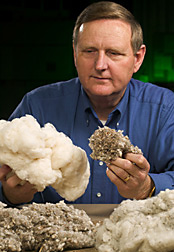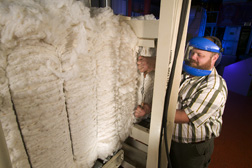New Technologies for Cotton Gins Combine for Big Savings
The ginning industry has faced many challenges in recent years. In fact, the number of gins operating in the United States has declined from 2,254 in 1980 to 896 in 2004. That’s why the Cotton Ginning Research Unit in Stoneville, Mississippi, is committed to helping solve problems facing domestic gins.
Initial research at the Stoneville lab in 1931 produced a patented method to remove excess moisture from cotton. Today the Stoneville lab takes a holistic approach to ginning research—from cotton varieties to mill processing techniques.
W. Stanley Anthony, an agricultural engineer and former research leader in Stoneville, recently retired after more than 35 years with the agency. During that time, ARS was awarded 20 patents for inventions created by Anthony and others in his laboratory.
The United States is a major producer of cotton, supplying about 20 million bales or about 20 percent of world output. Our export market has recently increased from 6 to 14 million bales, and new machines have been developed to help compete in foreign and domestic markets.
Although Eli Whitney’s 1793 invention to remove seeds from cotton revolutionized the economy of southern states, today’s standard gin equipment still ejects some valuable fiber along with the trash—leaf particles, sticks, stems, seed coat fragments, grass, and bark—that must be removed.
Most cotton is processed with the same machine sequence regardless of its needs, and as a result, good fiber is sometimes wasted. To resolve this problem, Ant hony developed and patented several equipment and software technologies. The research culminated in a process-control system known as “IntelliGin,” patented by Anthony and Richard K. Byler, an ARS agricultural engineer. The research unit’s best-known invention, it is now found in about 80 gins. With this technology, ginners can prescription-process cotton, improving its quality and increasing its value and profitability. An independent study found that IntelliGin can increase the net value of a bale of cotton by $8 for farmers.
Gin process control systems, such as IntelliGin, also focus on saw-type lint cleaners, which clean cotton fiber after it is removed from the cottonseed. They use 5 to 9 closely spaced grid bars to remove trash. Unfortunately, these types of cleaners also remove about 20 pounds of material per bale and can damage remaining fiber. Anthony invented and patented the louvered lint cleaner, which wastes less fiber and as a result, increases bale weight by 8 to 10 pounds.
“It has movable partitions of louvers between each pair of grid bars to allow the cleaning point of the grid bar to be engaged or disengaged on the fly, based on the needs of the cotton,” Anthony says. It’s marketed by Continental Eagle under the trade name “LouverMax,” and more than 120 units have been sold in less than 3 years.
Anthony developed two other machines to clean lint. One is a dual-saw cleaner. It consists of a standard saw-type lint cleaner plus a secondary saw, which prevents the longer fiber from being ejected with the waste. It may include a new doffing brush that reduces noise.
“The dual-saw cleaner retains about 6 more pounds of good fiber than a standard lint cleaner, with no significant difference in fiber quality,” he says. The device was licensed to a gin equipment manufacturer in December 2005.
A third patented invention combines a modified cylinder cleaner, normally used for seed cotton, with one or more lint cleaner saws.
“The new combined lint cleaner was evaluated in five studies, including operation at a commercial gin for 2 years,” he says. “Average fiber wasted was just 8 pounds per bale, compared to 15 pounds with one lint cleaner and 20 pounds with two lint cleaners.”
Cotton farmers using the technology can typically save $3 to $6 per bale. Companies have expressed interest in the combined lint cleaner, which can also be used with flax and kenaf.
Gins Do More Than Just Remove Trash
Other common problems encountered in gins include controlling cotton moisture levels and bale tie failures. The Stoneville ginning unit also addresses these issues.
Maintaining the proper moisture levels is necessary to preserve fiber quality for marketing and textile processing. It’s critical to cotton cleaning, handling, and fiber quality preservation at the gin. Cotton with high moisture content does not handle or clean well, and it degrades during storage. Fiber processed at low moisture is more brittle and easily damaged during ginning. When pressing and baling cotton at improper moisture levels, hydraulic pressure increases and causes excessive equipment wear. This also increases bale tie breakage. Researchers at Stoneville developed and implemented methods to properly apply, measure, and control moisture during processing. They also established the effect of moisture content on lint fiber color during bale storage for extended periods, resulting in an industry-wide recommendation for final bale moisture.
On average, about 4 percent of U.S.-produced bales—as many as 800,000—experience tie failures each year. Repair costs range from $10 to $45 a bale, an estimated $8 to $36 million annually. Some storage facilities have even reported tie failures of more than 10 percent. Replacing damaged bale ties on-site is now made simpler with a new device invented by Anthony.
The device recompresses the bales only in the specific area where the tie or ties need to be replaced.
Two companies are licensed to market the new bale tie replacer. Another, more robust bale tie replacement was invented for more demanding applications. It is currently being evaluated in warehouses in Mississippi and Georgia.—By Jim Core, formerly with ARS.
This research is part of Quality and Utilization of Agricultural Products, an ARS National Program (#306) described on the World Wide Web at www.nps.ars.usda.gov.
To reach scientists mentioned in this story, contact Linda Tokarz, USDA-ARS Information Staff, 5601 Sunnyside Ave., Beltsville, MD 20705-5129; phone (301) 504-1658, fax (301) 504-1486.
"New Technologies for Cotton Gins Combine for Big Savings" was published in the May 2006 issue of Agricultural Research magazine.









